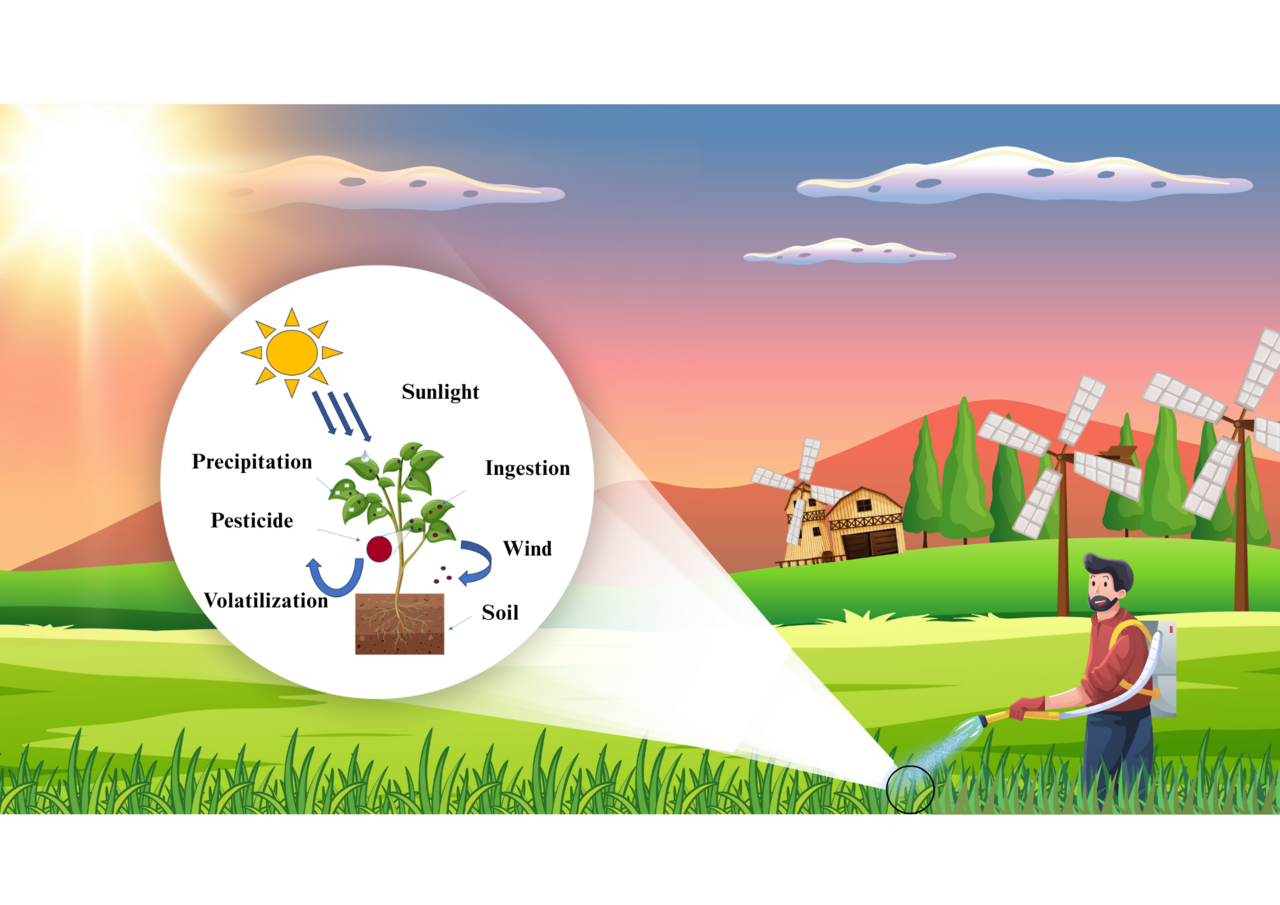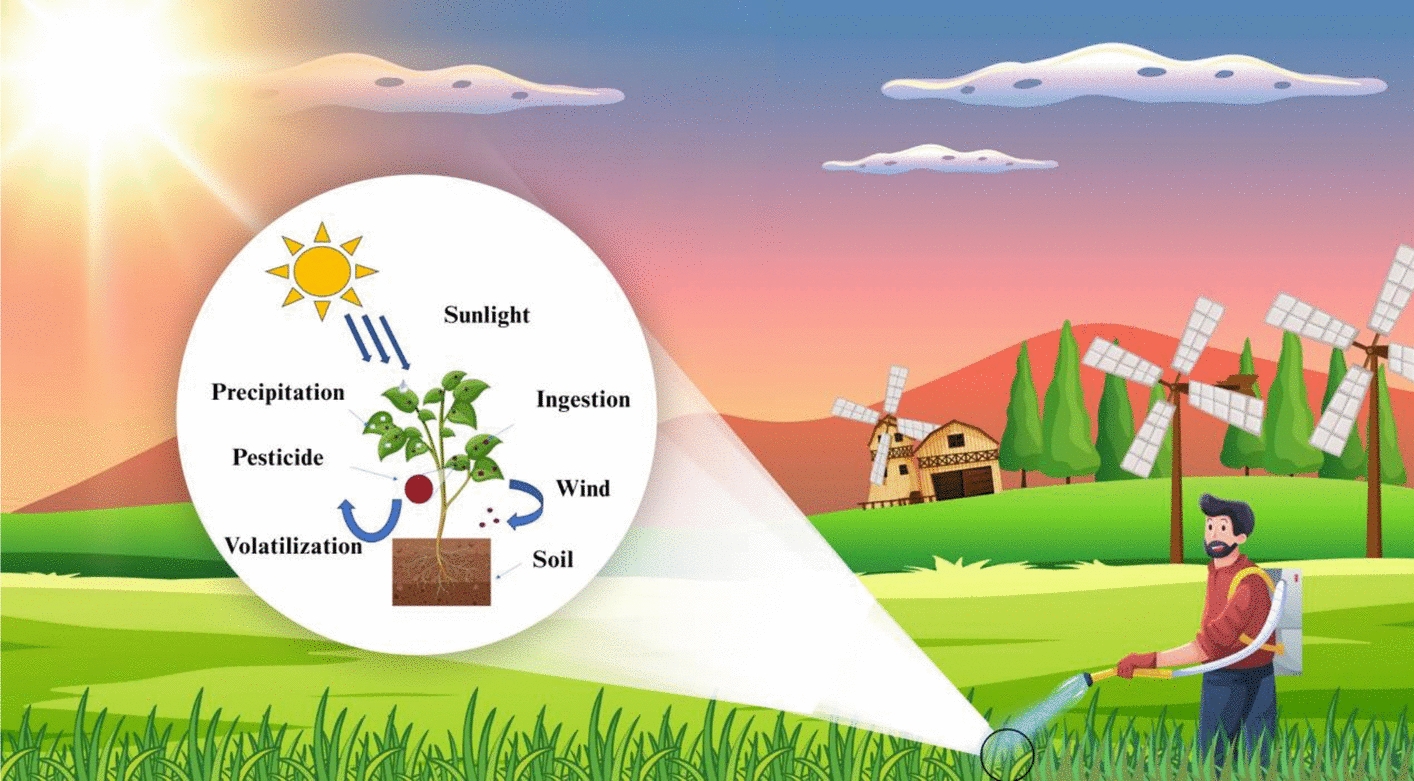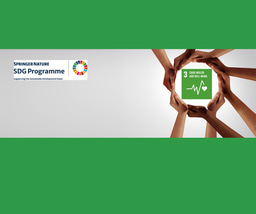The role of UV absorbers in preventing photodegradation and increasing lifespan of pesticides
Published in Earth & Environment, Sustainability, and Agricultural & Food Science

Pesticides are essential agrochemicals used to safeguard crops from various pests, diseases, and weeds, ensuring global food security and improved agricultural productivity. However, a significant challenge arises after their application. Many pesticides, when exposed to sunlight, undergo photodegradation before they can effectively penetrate the plant tissues. This has repercussions manyfold such as their reduced efficacy, formation of toxic photoproducts, need of frequent re-applications, and thereby increased environmental pollution.
To address this challenge, our review paper explores the role of ultraviolet (UV) absorbers in preventing the photodegradation of pesticides and thereby increasing their stability and field lifespan as one of the attractive strategies. The study emphasizes how photo-stabilization approaches can enhance both the economic efficiency and environmental sustainability of pesticide use.
Key Highlights of the Review:
- The paper provides a comprehensive overview of pesticide photodegradation mechanisms, including the chemical pathways by which UV radiation triggers degradation of active ingredients in the pesticide formulations.
- It also discusses the importance of photoprotection in maintaining pesticide performance, reducing the losses due to sunlight exposure, and minimizing the ecological impact of photoproduct formation.
- The review systematically summarizes the types and mechanisms of UV absorbers that can be incorporated into pesticide formulations. The review highlights in detail how UV absorbers quench the absorbed energy through non-radiative processes, thereby preventing molecular breakdown.
- A comparative analysis of bio-based and synthetic UV absorbers is also presented in the review, outlining their roles, efficiencies, and compatibility with various pesticide types.
- The study also includes a classification of pesticides along with their possible photodegradative pathways, illustrated through tables and figures for better clarity.
- The paper critically reviews the exhaustive literature on photostabilization, summarizing the contributions of different researchers, experimental conditions, and performance parameters such as photostability index and degradation rate constants.
Research Challenges and Insights:
The paper identifies several research challenges associated with the use of UV absorbers in pesticide formulations such as:
- Limited field data on large-scale implementation
- Intermolecular interaction between UV absorbers and pesticide active molecules
- Environmental persistence and biodegradability of synthetic absorbers
To overcome these limitations, the review proposes possible solutions and future research directions, such as:
- Designing eco-friendly, biodegradable UV absorbers derived from natural sources
- Developing hybrid nanocarrier systems that provide combined protection from UV and environmental degradation
- Conducting long-term field validation studies to assess real-world effectiveness under varying climatic conditions
Conclusions and Future Directions:
This review emphasizes that integrating UV absorbers into pesticide formulations is a promising and sustainable approach to prevent photodegradation, extend pesticide lifespan, and reduce economic losses. Laboratory studies indicate that UV absorbers can prolong pesticide efficacy, potentially reducing application frequency and environmental contamination.
The findings of this review aim to guide future research toward developing advanced photo-stabilized agrochemical formulations that are both effective and environmentally safe. The proposed strategies can contribute significantly to agricultural sustainability, resource efficiency, and the global effort to reduce chemical waste in farming practices.
Key Takeaways:
- UV absorbers can significantly reduce photodegradation of pesticide active ingredients
- Enhanced stability leads to better crop protection and reduces environmental impact
- Integrating UV absorbers into pesticide formulations promotes cost-effectiveness and sustainability in agriculture.
Follow the Topic
-
Discover Environment

This is a transdisciplinary, open-access journal that provides a leading platform for the rapid dissemination of knowledge and advances covering the research and innovation that is taking place across the environmental sector.
What are SDG Topics?
An introduction to Sustainable Development Goals (SDGs) Topics and their role in highlighting sustainable development research.
Continue reading announcementRelated Collections
With Collections, you can get published faster and increase your visibility.
Environmental Pollutants: Origins, Pathways, Impacts, and Sustainable Solutions
Pollution is a critical threat to ecosystems, human health, and the planet’s future. From industrial waste in China to microplastics in the Mediterranean and PFAS contamination in the U.S., pollutants spread across air, water, and soil, harming wildlife and communities worldwide. Understanding how these contaminants move, transform, and impact the environment is key to designing effective solutions.
This collection brings together cutting-edge research on pollution sources, environmental behavior, risks, and innovative cleanup strategies—covering everything from heavy metals in mining regions to pharmaceutical waste in urban waterways. We highlight advances in environmental science, green technology, and policy to tackle both long-standing and emerging threats like e-waste and AI-driven monitoring. The topics include, but are not limited to, the following:
• Pollution Origins: Industrial, agricultural, and urban sources, including legacy and emerging contaminants.
• Environmental Pathways: How pollutants travel through air, water, soil, and food chains.
• Risks and Impacts: Effects on biodiversity and human health, from local hotspots to global crises.
• Cleanup and Prevention: Nature-based solutions (like wetland restoration) and high-tech innovations (such as catalytic oxidation).
• Policy and Tools: Smart regulations, predictive modeling, and new detection methods.
This Collection supports and amplifies research related to: SDG 11
Keywords:PFAS, Heavy metals, Microplastics, Emerging Contaminants, Emission sources, Environmental forensics, Ecological indicators, Pollution sources, Contaminant transport, Ecological risk assessment, Pollutant fate and transformation, Bioaccumulation, Ecological restoration, Remediation technologies, Sustainable pollution management
Publishing Model: Open Access
Deadline: May 01, 2026
Mapping Sustainability: Geospatial Tools for Environmental Challenges
The escalating complexity of global ecological challenges demands innovative approaches to understanding, monitoring, and managing the environment. Geospatial technologies, including Geographic Information Systems (GIS), remote sensing, and spatial analytics, have become indispensable tools in addressing these issues. These technologies have demonstrated remarkable impact across various domains. For instance, in disaster management, the NASA-Disaster Response Coordination System utilizes satellite imagery and GIS analytics to assess damages from natural calamities, while the Copernicus Emergency Management Service (EMS) provides real-time mapping and early warning systems. In biodiversity conservation, initiatives like Global Forest Watch (GFW) and the Integrated Biodiversity Assessment Tool (IBAT) employ satellite data and spatial datasets to monitor deforestation and support conservation planning. Additionally, in urban sustainability, projects such as the Landsat Urban Heat Mapping Initiative help urban planners mitigate rising temperatures through targeted green infrastructure solutions.
This collection, "Mapping Sustainability: Geospatial Tools for Environmental Challenges," addresses critical gaps in the current literature by showcasing pioneering research that leverages geospatial technologies to confront urgent environmental issues. While existing research extensively explores geospatial methods, there is a significant need for more integrated, interdisciplinary approaches that translate data-driven insights into actionable solutions for sustainability. This collection advances the field by bridging science and policy, enhancing urban sustainability, advancing climate resilience, promoting data-driven conservation, and innovating spatial decision support systems (SDSS). Contributions that emphasize interdisciplinary research, innovative case studies, global perspectives, and policy insights are highly encouraged.
Keywords:Geospatial Technologies; Environmental Sustainability; Climate Change Analysis; Biodiversity Conservation; Pollution Monitoring; Water Resource Management; Spatial Data Analytics; Sustainable Development; Ecological Resilience; Geospatial Modeling; Spatial Decision Support Systems (SDSS); Remote Sensing Applications; Sustainable Urban Planning; Land Use and Land Cover Change (LULC); Disaster Risk Reduction (DRR); Ecosystem Monitoring; GIS-based Policy Analysis; Smart Cities and Resilient Infrastructure
Publishing Model: Open Access
Deadline: Jan 11, 2026





Please sign in or register for FREE
If you are a registered user on Research Communities by Springer Nature, please sign in